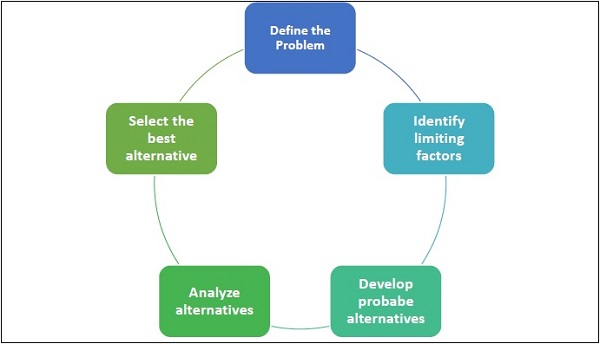
- Management - Introduction
- Management Principles - Home
- Management - Overview
- Management - Role Of Managers
- The P-O-L-C Framework
- Management - Evolution and Trends
- Classical Schools Of Thought
- Modern Schools Of Thought
- Management - Ecosystem
- Management - Environment
- Management - Factors Affecting
- Management - Organization
- Management - Leadership Styles
- Management - Framework
- Mission,Vision and Values
- Personalty and Attitude
- Work Attitude and Behaviour
- Decision Making
- Decision Making Nature Significance
- Factors Affecting Decision Making
- Decision Making - Styles
- Decision Making - Tools
- Management - Planning
- Planning - Introduction
- Types Of Plans
- The Planning Environment
- Organizational Structure
- Importance Of Organizing
- Principles Of Organizing
- Organizational Structure
- Organizational Process
- Change Management
- Organizational Change
- Organizational Change Factors
- Organizational Change Management
- Globalization and Its Effect
- Multinational Organizations
- Global Ecosystem and its Impact
- Management Useful Resources
- Management - Quick Guide
- Management - Useful Resources
- Management - Discussion
Factors Affecting Decision Making
Decisions are typically made under one of three conditions −
- Certainty
- Risk and
- Uncertainty
These conditions are based on the amount of knowledge the decision maker has regarding the final outcome of the decision. The manager's decision depends on a number of factors, like the manager's knowledge, experience, understanding and intuition.
Certainty
Decisions are made under conditions of certainty when the manager has enough information to know the outcome of the decision before it is made.
The manager knows the available alternatives as well as the conditions and consequences of those actions.
There is little ambiguity and hence relatively low possibility of making a bad decision.
Risk
Most managerial decisions are made under conditions of risk.
Decisions are taken in risk when the manager has some information leading to the decision but does not know everything and is unsure or unaware of the consequences.
Under conditions of risk, the manager may find it helpful to use probability estimates. This is where the manager’s experience and/or intelligence is of great help.
Uncertainty
Decisions are made under uncertainty when the probabilities of the results are unknown.
There is no awareness of all the alternatives and also the outcomes, even for the known alternatives.
Under such conditions managers need to make certain assumptions about the situation in order to provide a reasonable framework for decision making. Intuition, judgment, and experience always play a major role in the decision making process under conditions of uncertainty.
The decision-making process involves the following steps −
- Define the problem
- Identify limiting factors
- Develop potential alternatives
- Analyze and select the best alternatives
- Implement the decision

Define the Problem
The first step in the process of decision making is the recognition or identification of the problem, and recognizing that a decision needs to be taken.
It is important to accurately define the problem. Managers can do this by identifying the problem separately from its symptoms. Studying the symptoms helps getting closer to the root cause of the problem.
Identify Limiting Factors
In order to choose the best alternative and make a decision every manager needs to have the ideal resources − information, time, personnel, equipment, and supplies. But this is an ideal situation and may not always be possible.
A limiting factor is something that stands in the way of accomplishing a desired objective.
Develop Potential Alternatives
Recognizing the limiting factor in a given situation makes it possible to narrow down the search for alternatives and make the best decision possible with the information, resources, and time available.
Some methods for developing alternatives are −
Brainstorming, where a group works together to generate ideas and alternative solutions.
Nominal group technique is a method that involves the use of a highly structured meeting, complete with an agenda, and restricts discussion or interpersonal communication during the decision-making process.
Delphi technique where the participants do not meet, but a group leader uses written questionnaires to conduct the decision making.
Analyze the Alternatives
This is an important stage in the decision-making process and perhaps the toughest. Managers must identify the merits and demerits of each alternative and weigh them in light of various situations before making a final decision.
Evaluating the alternatives can be done in numerous ways. Here are a few possibilities −
- Qualitative and quantitative measurements
- Perform a cost‐effectiveness analysis for each alternative
- Marginal analysis
Selecting Alternatives
Once the alternatives are analyzed and evaluated, the manager has to choose the best one. The manager needs to choose the alternative that gives the most advantage while meeting all the required criteria. Sometimes the choice is simple with obvious benefits, at times the optimal solution is a combination of several alternatives. At times when the best alternative may not be obvious, the manager uses probability estimates, research and analysis aided by his experience and judgment.
Evaluating Decision Effectiveness
The job of the managers does not end with making decisions. They are also responsible to get favorable results from the decision taken and implemented.
The effectiveness of a decision can be understood through a systematic and scientific evaluation system that provides feedback on how well the decision is being implemented, what the results have been, and what amendments and adjustments have been made to get the intended results.